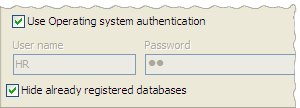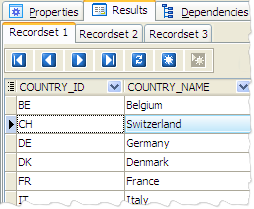Oracle Maestro 8.12 released
Dec 3, 2008
| Prev | Next |
|
|
- The new version allows you to connect to Oracle databases using the Operating system (OS) authentication. This security mode allows Oracle to pass control of user authentication to the operating system. The technology works as follows:
- First, create an OS user (if it doesn't exist).
- Check a value of the Oracle OS_AUTHENT_PREFIX initialization parameter. Current value of this parameter can be retrieved using the followng query:
SELECT VALUE FROM V$PARAMETER WHERE NAME = 'os_authent_prefix'
The default value is OPS$. - Create a database user. The user must use the external identification and its name must be the prefix value concatenated to the OS username (on Windows platforms you would expect an Oracle username of "OPS$DOMAIN\MY_USER" for the user "my_user").

- Check Use Operating system authentication in the Create Database Profiles Wizard or Edit Database Profile window.

- First, create an OS user (if it doesn't exist).
- An ability of using autoincrement columns has been incorporated into the Field Editor. As Oracle doesn't support the auto increment attribute directly, Oracle Maestro creates a sequence and/or a trigger.
- Starting with this version it is possible to use virtual columns (Oracle 11g). Such column are useful for storing derived data. Derived values for virtual columns are calculated by defining a set of expressions or functions that are associated with the virtual column when the table that the column is going to reside in is created.
Example. Assume that we have an EMPLOYEE table with SALARY and YEARS_OF_SERVICE columns. The column below derives the current value of the employees’ retirement benefit, which is a formula based on the employee’s years of service, the total salary, and a multiple.

- Index editor: support for invisible indexes has been added (Oracle 11g).
- The algorithm of compiling object dependencies has been significantly updated. Now it processes the objects recursively. Also the compiling and debugging commands have been united into a separated group as follows:

- A possibility of executing stored procedures returning cursors has been implemented. If a procedure returns several cursors, Oracle Maestro will display several result sets in the separated tabs.

- Get SQL Dump Wizard now can generate multi-row INSERT statements. Also the wizard has been redesigned to increase the usability.
- Visual Query Builder has been dramatically improved. Now it can produce INSERT, UPDATE and DELETE statements as well as the SELECT statements containing subqueries and/or UNIONs.
- Data grid features the following things:
- Starting with this version it is possible to use the lookup editor for a column, which is linked by a foreign key with a (single) column from another table. The editor displays the contents of parent table’s columns within the dropdown window.
- A possibility of displaying data in the master-detail form has been incorporated into the Table Editor (multiple detail pages can be displayed for a single master row). Use the Show/Hide details link at the editor’s navigation bar to activate/deactivate this view mode.
- Filtering, grouping, and sorting features become available for CLOB columns.
- The notification pane is now displayed after simple mode activation (filtering, grouping and sorting features are not supported in this mode). All the related settings can be customized in the Options dialog.
- Starting with this version it is possible to use the lookup editor for a column, which is linked by a foreign key with a (single) column from another table. The editor displays the contents of parent table’s columns within the dropdown window.
- The Dependency tracker tool has been implemented (Main Menu | Tools | Dependency tracker). Use this tool to browse all-level dependencies of a schema object (table, view, function, etc).
- All schema object (table, view, procedure, etc) editors: the tab captions are now displayed as object@schema instead of schema.object. This should increase the usability while working with a lot of objects in the same schema.
Current version: 
Previous version: 
- SQL Script Editor: Script Explorer has been significantly improved. Now it works much faster and more exactly.
- PL/SQL Debugger: an ability to drag and drop a variable from the source code window to the watch list has been implemented.
- Session Browser: the statements at the Last SQL tab are now formatted if possible.
- Database Explorer: the Data management group has been added to table and view nodes popup menus. Use this group items to run Data Export, Data Import, and Get SQL Dump wizards for the selected table or view without opening its editor (the Empty Table command has been moved to this group too). The Go to foreign table command is now available for all the foreign keys.
- Database Designer settings: the "Show hints" options has been added. Also it is now possible to select the default graphic file format to export diagrams as images.
In addition to this, several bugs have been fixed and some other minor improvements and corrections have been made.
Related links:
Oracle Maestro home pageDownload Oracle Maestro
Get Oracle Maestro Tour
Purchase your license of Oracle Maestro today!
| Prev | Next |








